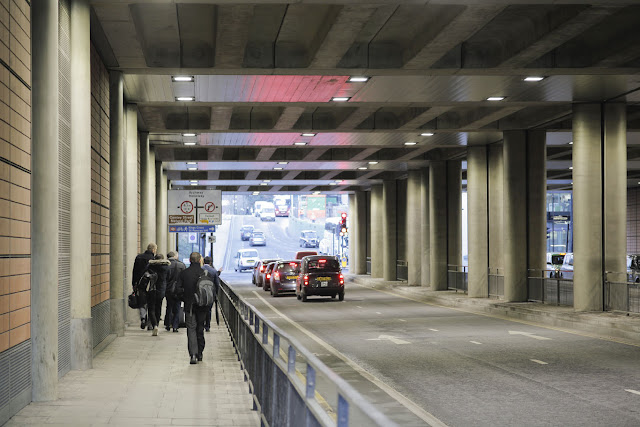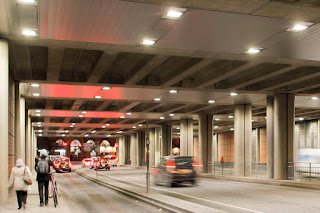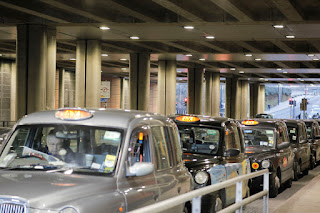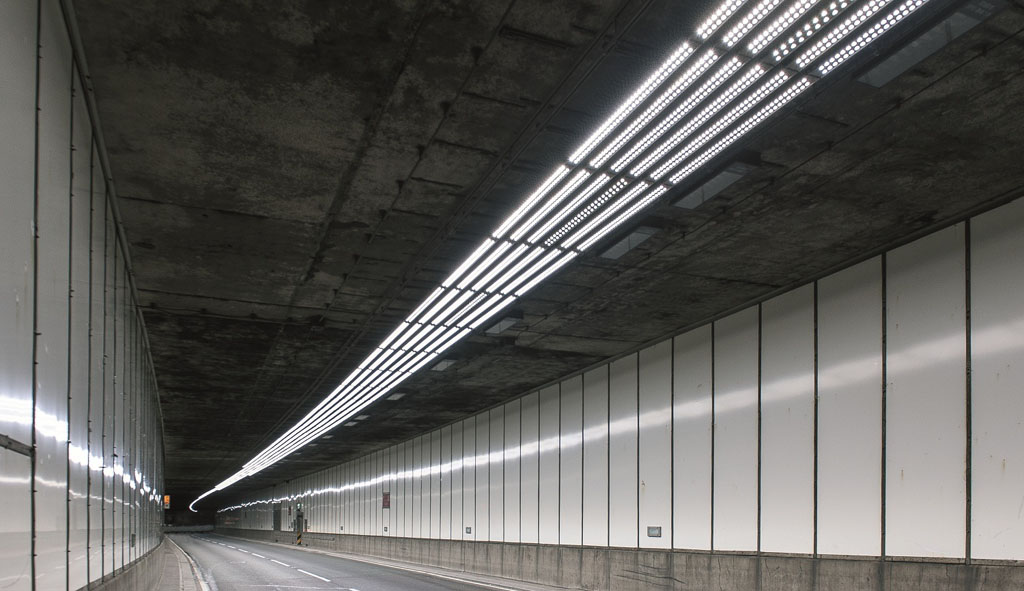TAG | street lighting
Streetlights powered by footsteps are unveiled in Las Vegas. PLUS: World’s first live li-fi test takes place at LuxLive. AND: Lux Award winners revealed at a ceremony in London. Lux Today December 6th 2016.
led street lighting · led streetlight · li-fi · lux today · luxlive · Novel Energy Lighting · street lighting
19
LEDs cut costs in North London underpass
Comments off · Posted by admin in LED, LED downlights, LED Floodlights, Philips LED

This underpass near King’s Cross and St Pancras stations in North London is saving money on energy and maintenance since it had its old metal halide lights replaced with specially designed LED road tunnel luminaires from Philips.
The St Pancras Road underpass is a busy road, cycle and pedestrian route to the two major train stations, as well as providing access to Camden Council’s new offices. It was previously lit by around 100 twin-lamp metal halide fittings and the council saw an opportunity to visually improve what had become a gloomy and uninviting area. This was a ‘spend to save’ initiative to take advantage of energy-efficiency gains and lower maintenance costs while also reducing carbon emissions.
The lighting design was carried out by Philips and the new luminaires were installed by main contractor SPIE. SPIE’s John Broster said: ‘The previous luminaires were fitted into the soffit of the underpass and as this is a concrete strutted roof it would have been impractical to alter it. We needed a solution that could provide a direct replacement for the existing fittings.’
The stainless steel luminaires have been installed on a one-for-one replacement basis, to provide energy savings of more than 50 per cent. The new lighting has increased light levels and uniformity to remove the gloom, while the 4000K neutral white colour temperature has created a better and more inviting visual environment for users of the underpass. The tunnel feels safer and more pleasant.
The project also provided an ideal opportunity to make better use of lighting control. ‘As this is a short underpass the lighting only requires one-step dimming and we were able to adjust the existing system, using high light levels during the day and dimming at night to minimise the contrast for drivers entering the underpass,’ said Broster.
The council has achieved a significant reduction in energy consumption, while also reducing maintenance costs as the luminaires are expected to be virtually maintenance-free throughout their lifetime, and should pay for themselves in about five years.
Contact Novel Energy Lighting to discuss your LED lighting retrofit requirements. We work hand in hand with the major lighting manufacturers like Philips to specify, supply, and install projects. Tel: 0208-540-8287. Email: sales@novelenergylighting.com
led floods · LED lamps · led lighting · LED luminaires · led tunnel lighting · lux · Novel Energy Lighting · philips led · street lighting · tunnel lighting · urban lighting
18
Osram safeguards LED road luminaires with high overvoltage protection
Comments off · Posted by admin in LED
The power consumption benefits from LED street lighting could be compromised by the threat of voltage peaks from lightning strikes.

Lightning density in Europe differs significantly from region to region. Mandatory image source specification: © British Crown copyright 2015, the Met Office
Cities like Milan and Turin are expecting at least 50 percent less electricity consumption thanks to recent transformations to LED and Optotronic control devices from Osram. However, lightning strikes can risk the economic advantages as LED modules run with lower voltage levels and could be damaged from overvoltage. This danger has increased with the UN Climate Council identifying increasing levels of lightning worldwide in its fifth assessment report (IPCC14). Around 10 percent of the several million lightning strikes occurring each day impact on the ground, thereby causing voltage peaks. To effectively protect LED modules assembled in road luminaires, the Osram Optotronic 4DIM features overvoltage protection of 8 kilovolts as standard.
Levels of lightning density in Europe are high in summer, particularly in July and August, and with large regional differences – the U.K. Meteorological Office recorded between just 0.25 and over 20 strikes per square kilometre in 2014. In general it can also be said about distribution across Europe that lightning in the South East occurs more frequently than in the North or North West, and in towns and cities more than in rural areas
As a consequence, the new generation of Osram “Optotronic 4DIM” electronic control units feature protection of up to 8 kilovolts between mains supply and ground in protection classes I and II. This means that lightning can strike an area of up to 200 metres from a luminaire mast without the LED module being damaged.
Compared to the common 4 kilovolt overvoltage protection with control units of other manufacturers, this means that with an example mast spacing of 30 metres, twice the quantity of road luminaires survive lightning impacts without damage. In many European regions the high level of overvoltage protection with Optotronic 4DIM units is usually sufficient to provide long term protection. However in regions with high lightning density levels though, it is recommended as a precaution to implement supplementary protective measures, for example in the main distribution frames and junction boxes of road lighting systems.
Osram as the first manufacturer made this 8 kilovolt protection possible with a so-called EQUI connection (equipotential) for protection class II applications, enabling various components of the lighting system to exhibit the same electric potential, thus significantly reducing the occurrence of overvoltage on the LED module.
Optotronic control units also reliably protected from voltage peaks from two other hazardous sources: – those with up to 6 kilovolts due to load changes or switching commands in the power supply grid (often generated several dozens of times per year), and from electrostatic discharge (ESD) occurring with for example maintenance work, if no ESD protective measures exist.
Overvoltage though does not automatically mean the immediate failure of an LED module, but can cause premature ageing and therefore shorter operating periods; this has consequences for the operator in terms of costs. Normally, LED solutions have low failure rates and achieve up to 100,000 operating hours.
Novel Energy Lighting supplies all Osram LED products. Talk to us today about your requirements for LED lighting, and LED street lighting. Tel: 0208-540-8287, Email: sales@novelenergylighting.com
led lamp · led lighting · led street light · led streetlights · Novel Energy Lighting · osram · osram led · osram street lighting · street lighting
12
Light at the end of the tunnel (and slightly dimmer light in the middle)
Comments off · Posted by admin in LED, Philips LED
Until recently, this tunnel in Stoke-on-Trent, England, had to be regularly closed to change failed lamps, causing disruption to drivers.
I have reduced my overall maintenance costs, saved a substantial amount of money in energy costs, reduced the carbon footprint and reduced the risks for the operatives’Paul Diamond, Amey
amey · energy efficiency · energy saving lighting · highway lighting · led lighting · Novel Energy Lighting · philips led · philips linear led · street lighting · tunnel lighting
11
The man who’s making Britain’s councils look twice at their LED streetlighting specs
Comments off · Posted by admin in LED, LED Floodlights
‘LED streetlighting is being imposed on people and any negative feedback is being ignored’ – campaigner Simon Nicholas
Simon Nicholas insists he’s not ‘anti-LED’.
It’s a point worth making, as he has become famous in lighting circles for his one-man campaign against bad LED streetlighting.
‘I believe LED is the future of lighting,’ he says. ‘But it’s a sophisticated technology being used crudely because of a lack of expertise. There’s a lack of understanding of the wider issues and a lack of skills within many local authorities.’
‘In many cases it’s cheap and cheerful. It’s not even cheerful, it’s cheap and nasty. In fact it’s not even cheap, it’s expensive and nasty. And if residents complain, all they get back from their local authorities are cut-and-paste platitudes.’
Nicholas thinks taxpayers deserve better, so he has made it his business to get councils to look more carefully at how they procure and specify LED streetlighting – and he’s getting results.
Looking for answers
In a world of confusion and misinformation about LEDs, many lighting professionals dream of customers who are as well informed about lighting as Nicholas. It’s not often you hear members of the general public throwing around terms like spectral composition and luminaire lumens per circuit watt. But be careful what you wish for: Nicholas has been giving manufacturers and local authorities a pretty hard time about their products and practices.
Nicholas is not a lighting man by background. He’s a mechanical engineer who runs a couple of transport and property businesses, and until recently had no more than a passing interest in LED lighting.
But when his local council in Trafford, Greater Manchester tried to replace the streetlights in the conservation area where he lives with brighter lights on higher masts, he complained, and succeeded in getting changes made.
Then he got wind of Trafford’s plans to roll out LEDs, and began to examine their plans.
Since then, his campaign against what he sees as bad LED lighting – either because it’s poorly designed, bad value for money, foisted on people without consultation or potentially damaging to health – has become, in his words, ‘a hobby’.
He hit the headlines in 2013 when the Manchester Evening News quoted (or rather paraphrased) him as saying that LED lights might ‘damage brains’, and last year he appeared on the BBC’s Daily Politics to speak out against bad lighting.
In his spare time Nicholas devours academic papers and policy documents, attends technical seminars on lighting, fires off regular Freedom of Information requests to councils and gets into lengthy arguments on theLighting Talk discussion group on LinkedIn.
He even came to LuxLive last year, and debated LED streetlighting alongside representatives of Westminster City Council, Balfour Beatty and manufacturer CU Phosco. Whatever you think about his views, he’s determined, engaged with the issues and very well informed.
It’s not all about energy
So what’s at the heart of Nicholas’ problem with LED streetlighting? Surely the benefits of this new technology – energy efficiency, light control, colour quality – are compelling?
‘The only criteria anyone cares about is energy efficiency,’ Nicholas told Lux. ‘When you’re introducing LED lighting, the whole process needs to be managed in a very measured and controlled way, and aspects other than energy efficiency need to be considered.’
One of his biggest concerns is the health risks of glare and blue-rich light from LEDs. It’s certainly true that blue light – in certain intensities and under certain circumstances – can damage the eye or disrupt sleep. Many experts insist that fear about the blue in LED streetlights is misplaced, but Nicholas is not satisfied that the risks have been properly researched or addressed.
Not only is there a ‘technical guidance void’ on how best to use LED technology for streetlighting, he says, there’s also a ‘policy void’. ‘Someone needs to put out some guidance. In my view it’s the responsibility of central government, but they don’t seem to have any appetite for it.’
‘Clients are just believing what people are telling them and taking a leap of faith. They’re being promised fit-and-forget for 20 years. In 11 years when the arrays have deteriorated, the driver has blown and the technology has moved on, what are you going to do then?’
He also objects to what he sees as an undemocratic approach to the introduction of LEDs. ‘This new technology is being imposed on people,’ he says. ‘Any negative feedback is being ignored.’
It’s not just Trafford Council that Nicholas has been complaining to – he has also targeted other local authorities, particularly those who have ‘made a big PR deal of what they’re doing’, such as Wigan.
‘They said they had done a trial and were going to extend their trial across the borough,’ Nicholas said. ‘So I ask them a number of questions and they’re struggling to answer them. So I send them some information and ask them to consider it, and as a result they’ve decreased the colour temperature by 40 per cent. I don’t know on what basis they’re thinking 4000K is OK and 5700K is not, but it’s a step in the right direction.’
Nicholas believes local authorities should explore the option of dimming existing streetlighting, which still has years of life left in it, rather than spending millions on brand new LEDs. ‘Manchester and Cardiff have both invested heavily in high-intensity discharge lighting over the last 15 years,’ he says. ‘Cardiff are spending £1.7 million to dim 22,365 lights and saving £312,000 a year. In Manchester they could save £570,000 [if they did the same]. Instead they’re planning to save £750,000 a year on an LED rollout that’s going to cost £33 million, and all the kit they’ve installed in the last 10 years goes in the skip. The lighting level will be less, the glare will be greater and generations of taxpayers will be paying for the debt.’
Follow the money
The way LED rollouts are funded doesn’t always help, Nicholas says. Initiatives like the Green Investment Bank’s loans for lighting upgrades worry him, because he feels they have not paid sufficient attention to quality, including health and environmental issues.
‘They seem happy to subsidise bad as well as good lights,’ he said. ‘The risk is that a local authority who got Green Investment Bank funding go and squander it on poor quality equipment and it won’t work and the company goes bust and the taxpayer is left holding the baby.’
He’s equally unimpressed by private finance initiatives. ‘PFI and LED are not happy bedfellows,’ Nicholas says. ‘The objectives of the PFI supplier and the client are, in my view, mutually exclusive. The contractor wants to do as much as possible and the client just wants to save money. And the contractor doesn’t necessarily give the client the best solution. Manchester is a clear example of this.’
Does he have much faith that the lighting industry will address his quality concerns? ‘No. I’m not sure self-regulation will work. We’ve got a perfect storm of new technology, huge financial pressures on local authorities and a lack of guidance from central government. That’s where the buck has to stop.’
But he has seen positive changes in attitudes from councils with whom he has raised his concerns. ‘I’ve been locked in a battle with Trafford for over 18 months and now we are starting to see some positive results, with a change of emphasis from purely energy savings to consideration of those wider environmental and health impacts which can result from the specification of the wrong spectral composition of outdoor lighting.’
Meanwhile, Cardiff Council has invited him to discuss LED specifications with its highways team, and he’s helping the ILP (the Institution of Lighting Professionals) update its guidance on LEDs.
A couple of years on from getting involved with LED lighting, Nicholas still hasn’t lost momentum. And if central and local government want to come up with effective lighting policies, and win the public round to them, they would do well to pay attention to determined, knowledgeable critics like this.
After all, Nicholas says: ‘If there were any serious counter-argument I’d have heard it by now. And I probably would have gone away.’
Novel Energy Lighting works with councils and developers to specify LED Street Lighting. Call us to discuss your needs: 0208-540-8287, or email: andrew.shuttleworth@novelenergylighting.com
energy efficient lighting · LED lamps · led lighting · led street lights · led streetlighting · Novel Energy Lighting · street lighting






